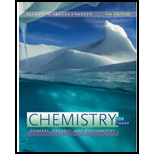
Concept explainers
Interpretation:
The volume of air that would be needed to combust
Concept introduction:
The stoichiometry of a chemical species involved in a
Where,
•
•
Answer to Problem 11.68E
The volume of air that would be needed to combust
Explanation of Solution
The complete combustion reaction of methane is represented as,
The given mass of methane is
The molar mass of oxygen is
The molar mass of methane is
The number of moles of a substance is given as,
Where,
•
•
Substitute the mass and molar mass of methane in the equation (1).
Therefore, the number of moles of methane present in the reaction mixture is
One mole of methane reacts with two moles of oxygen gas. Therefore, the relation between the number of moles of methane and oxygen is given as,
Where,
•
•
Substitute the value of
The pressure of a substance at STP is
The temperature of a substance at STP is
The ideal gas equation is given as,
Where,
•
•
•
•
•
Rearrange the above equation for the value of
Substitute the value of number of moles of oxygen,
Therefore, the volume of oxygen required to react with methane is
It is given that air is composed of about
The formula for volume percentage is represented as:
Where,
•
•
Rearrange the above equation for the value of
Substitute the value of volume percentage of oxygen and volume of oxygen in the equation (5).
Therefore, the volume of air that would be needed to combust
The volume of air that would be needed to combust
Want to see more full solutions like this?
Chapter 11 Solutions
Bundle: Chemistry for Today: General, Organic, and Biochemistry, Loose-Leaf Version, 9th + LMS Integrated OWLv2, 4 terms (24 months) Printed Access Card
- What volume (in liters) of O2, measured at standard temperature and pressure, is required to oxidize 0.400 mol of phosphorus (P4)? P4(s) + 5 O2(g) P4O10(s)arrow_forwardHow does hydraulic fracturing differ from previously used techniques for the recovery of natural gas from the earth?arrow_forwardIf an electric current is passed through molten sodium chloride, elemental chlorine gas is generated as the sodium chloride is decomposed. :math>2NaCl(1)2Na(s)+Cl2(g) at volume of chlorine gas measured at 767 mm Hg at 25 °C would be generated by complete decomposition of 1.25 g of NaCl?arrow_forward
 Chemistry & Chemical ReactivityChemistryISBN:9781337399074Author:John C. Kotz, Paul M. Treichel, John Townsend, David TreichelPublisher:Cengage Learning
Chemistry & Chemical ReactivityChemistryISBN:9781337399074Author:John C. Kotz, Paul M. Treichel, John Townsend, David TreichelPublisher:Cengage Learning Chemistry & Chemical ReactivityChemistryISBN:9781133949640Author:John C. Kotz, Paul M. Treichel, John Townsend, David TreichelPublisher:Cengage Learning
Chemistry & Chemical ReactivityChemistryISBN:9781133949640Author:John C. Kotz, Paul M. Treichel, John Townsend, David TreichelPublisher:Cengage Learning Chemistry: The Molecular ScienceChemistryISBN:9781285199047Author:John W. Moore, Conrad L. StanitskiPublisher:Cengage Learning
Chemistry: The Molecular ScienceChemistryISBN:9781285199047Author:John W. Moore, Conrad L. StanitskiPublisher:Cengage Learning- Chemistry: Matter and ChangeChemistryISBN:9780078746376Author:Dinah Zike, Laurel Dingrando, Nicholas Hainen, Cheryl WistromPublisher:Glencoe/McGraw-Hill School Pub Co
 Chemistry: Principles and PracticeChemistryISBN:9780534420123Author:Daniel L. Reger, Scott R. Goode, David W. Ball, Edward MercerPublisher:Cengage Learning
Chemistry: Principles and PracticeChemistryISBN:9780534420123Author:Daniel L. Reger, Scott R. Goode, David W. Ball, Edward MercerPublisher:Cengage Learning Introductory Chemistry: A FoundationChemistryISBN:9781337399425Author:Steven S. Zumdahl, Donald J. DeCostePublisher:Cengage Learning
Introductory Chemistry: A FoundationChemistryISBN:9781337399425Author:Steven S. Zumdahl, Donald J. DeCostePublisher:Cengage Learning





